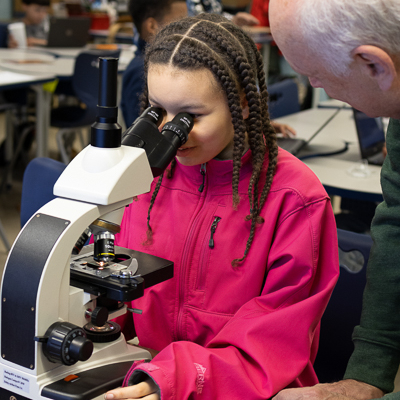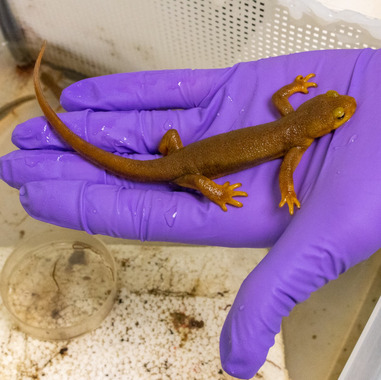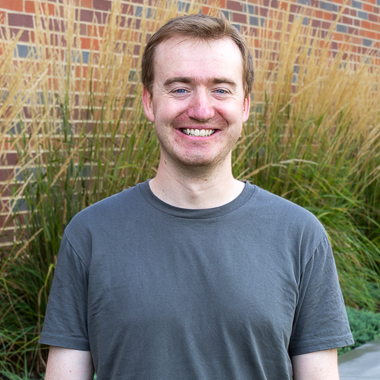New discovery about Campylobacter Jejuni may lead to a non-antibiotic treatment
Article Highlights
- Campylobacter jejuni, or "Campy," is the leading cause of bacterial foodborne human gastroenteritis in the United States, and it is becoming antibiotic-resistant.
-
In a paper published in the Proceedings of the National Academy of Science, MSU researchers Ritam Sinha, Victor DiRita, and colleagues explain that the way that our immune system responds to the presence of Campy creates the perfect environment for it to grow.
- Campy's presence in the gut causes a condition called "cryptic hyperplasia" which increases lactate and oxygen levels. These changes allow Campy to use lactate as a food source. Modifying how Campy utilizes lactate may lead to a non-antibiotic treatment.
When food poisoning is in the news, Salmonella or E.Coli typically get the blame. MSU researchers say there’s another, even more common, culprit at work.
Campylobacter jejuni, known as “Campy” to researchers, is the leading cause of bacterial foodborne human gastroenteritis in the United States. The CDC estimates that it is responsible for 1.5 million cases each year.
Campy is found naturally in chickens, but it doesn’t make them sick. Humans are a different story. When people eat undercooked poultry or when the raw meat is not handled properly, Campy can infect the gut and cause terrible diarrhea, fever, vomiting and cramping. It can even be life-threatening to immunodeficient patients, such as those infected with HIV.
What’s even more troubling is that Campy is becoming increasingly resistant to antibiotics, which means it’s becoming more difficult to treat.
Researchers in MSU’s Department of Microbiology, Genetics, & Immunology, or MGI, are investigating how Campy causes infections in humans in the hopes of developing a non-antibiotic-based treatment.
In a paper published in the Proceedings of the National Academy of Science, they explain that the way that our immune system responds to the presence of Campy creates the perfect environment for it to grow.

“This research is an attempt to understand how this pathogen grows within the host during infection,” said Victor DiRita, Rudolph Hugh Endowed Professor and MGI Department Chair. “That sounds like a simple question, but at the same time as the pathogen is trying to grow, the host is mounting an immune response – and it’s a pretty aggressive immune response. Nevertheless, Campy grows quite well in the face of it.”
Ritam Sinha, research investigator in the DiRita lab and lead author on the study, and colleagues used a ferret infection model to determine that when Campy is present in the human gut, the gut physically changes. A condition called cryptic hyperplasia occurs. Crypts are glands found in the lining of our intestines. They are responsible for renewing the intestinal lining and for maintaining proper intestinal function. “Hyperplasia” is when the cells in an organ or tissue begin reproducing more quickly. When cryptic hyperplasia occurs, the intestinal crypts become deeper, and several effects occur.

Among these is that lactate levels in the large intestine go up.
Previously published research demonstrated that Campy can use lactate, the same chemical
that causes muscle soreness after exercise, as a carbon source when it is grown in
a laboratory. However, it had not been determined that Campy required lactate to grow
during infection.
To determine if lactate was the primary food source for the pathogen, Sinha devised
an experiment in which he created a mutant strain of Campy that was missing the gene
for LctP, a key lactate transporter. When this strain of Campy was tested against
unmodified, or “wild type,” Campy, the difference was stark.
“We found that the population of wild type Campy was much higher than the mutant in the infected ferrets. The mutant Campy couldn’t grow because it couldn’t use the lactate,” said Sinha, “So, we are certain that lactate is the main carbon source.”
Another effect of cryptic hyperplasia is that the normally oxygen-limited gut environment becomes more oxygenated.
“A previous study found that it’s almost a 5% increase in oxygen. That’s significant,” Sinha said.
It turns out that this is exactly what Campy needs to use the lactate as a food source.
“We discovered that in the presence of oxygen, Campy can take up lactate. But in anaerobic conditions, where there is no oxygen, they can’t. So, what is regulating it?” Sinha said, “I then discovered a regulator that can control the lactate transporter expression in Campy.”
What Sinha discovered is an elegant mechanism that controls whether lactate can be used as a food source for the Campylobacter, and it’s entirely dependent upon the amount of oxygen present.
The hypothesis is that the mechanism hinges on a protein that changes shape in the presence of oxygen. In anaerobic conditions, the protein binds to a specific site on the Campy DNA and prevents the genetic machinery from expressing the gene for LctP, the protein that Sinha showed previously was required for Campy to use lactate.
However, when oxygen is present, the shape of the protein changes, and as a result it binds poorly to the DNA. Without anything inhibiting the gene expression machinery, LctP is produced, and Campy can use lactate to grow.
“Another aim is to understand how the lactate works with Campylobacter jejuni, because that would be another way to manipulate it, right?” Sinha said. “Maybe we could change the way it uses the lactate or maybe we could find inhibitors or drugs that can block the lactate uptake system.”
This new understanding about Campy growth during infection is an important breakthrough that has led to new research questions. The lab has already received a new National Institutes of Health grant to begin studying the effects of manipulating the level of lactate in the host.
“Maybe this is a way to treat Campylobacter infection,” said DiRita, “If you can just starve it of what it needs to grow, then you limit how well the bacteria will grow during infection.”



